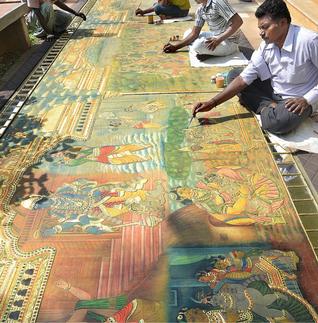
When his room-mate introduced him to Tanjore painting a quarter century ago S.V. Valliappan would not have imagined he would come out with a masterpiece one day.
On May 11, Valliappan, a drawing master in the Kandanur Chittal Achi Memorial Higher Secondary School near Karaikudi, was the happiest man as he had completed his masterpiece, a 26-foot long 8-foot wide Tanjore painting, depicting the life of Lord Krishna.
He was busy giving final touches before the painting, made in three pieces of wooden planks, was taken for packing at the front yard of his house at Karaikudi to be transported all the way to Kolkotta.
An art-loving businessman from Kolkotta has ordered the painting to install it at the entrance of his renovated heritage house.
“I took it as a challenge, when Sanjay Sachdev running Domus Art Gallery in Kolkotta approached me through e-mail and asked whether I could do the project for him, as I have never attempted such a huge painting in my career,” says Valliappan.
Talking to The Hindu , the middle-aged Valliappan said he was excited about the size of the painting when Mr Sachdev detailed the project. He consulted his octogenarian father C.V. Sivaraman, an expert in stump powder paintings, and accepted the challenge after his father said he could do it.
Mr Sachdev, who was doing liaison for his architect friend, however, gave him the project only after Valliappan made a painting of Lord Ganesh, a breathtaking brilliant piece.
After completing the formalities, he started the painting in January and completed it in five months under the watchful eyes of his father and Sachdev. Two artists and two carpenters assisted him, he says.
“We used to start the work at 4 a.m. and go on till 8 a.m. in the morning session. In the evenings, we used to work from 6 p.m. to even beyond midnight,” Mr Valliappan says. They used teakwood planks and canvas cloth as the base. As the customer wanted it in antique style, he made the gold glitter more sober and used subtle colours. More than 1000 numbers of 22 carat gold foils and 5000 imitation stones have gone into painting, he said.
The four sides of the frames, surrounding the borders, were adorned with mirrors in squares and cotton thread covered with gold foil to provide the elegance.
“I learnt a lot after completing the project,” says Valliappan, striking humble. He was not sure he could get into the Guinness Book of World Records as the painting was not in single piece and done in three pieces to be fixed as one frame.
He took interest in Tanjore paintings after his room-mate Mayilvaganan in Chengalpattu introduced him the art, when he had gone for teacher training course in St. Xavier Higher Secondary School in 1987, he says.
After a three month course, he developed interest, he recalls.
Mr Sachdev and his architect friend took interest in the classical south Indian painting, when they visited ‘Naivedyam’, a south Indian restaurant in Delhi, where they saw a Tanjore painting.
Impressed with the art form, the architect decided that he would suggest this painting to his businessman customer and when the latter gave the nod, they searched for the artistes. After searching through the internet, they shortlisted half a dozen artistes in Bangalore and Coimbatore and zeroed in on Mr Valliappan.
“While others sounded commercial and not devoted to the subject work, Valliappan looked genuine,” Mr Sachdev, who was making his fourth visit to Karaikudi to oversee the packing, told The Hindu .”
The only condition laid was that the painting should depict the happy life of Lord Krishna and there should not be snakes or bloodshed, keeping the vaastu point of view.
Mr Sachdev promised more orders for Valliappan as Mr Sivaraman looked at his son proudly.
source: http://www.thehindu.com / The Hindu / Home> Miscellaneous / by D. J. Walter Scott / Sivaganga – May 18th, 2013